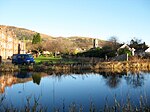Duncolm
Marilyns of ScotlandMountains and hills of West DunbartonshireScotland geography stubs
Duncolm (Scottish Gaelic: Dùn Choluim) is a hill in Scotland. It is the highest point in both West Dunbartonshire and the Kilpatrick Hills, at an elevation of 401 metres (1,316 ft). Its name means "Fort of Columba". It lies near Loch Humphrey. There is an easy path to the summit from the south-west, which passes over two subsidiary peaks, Little Duncolm and Middle Duncolm.
Excerpt from the Wikipedia article Duncolm (License: CC BY-SA 3.0, Authors).Duncolm
Geographical coordinates (GPS) Address Nearby Places Show on map
Geographical coordinates (GPS)
| Latitude | Longitude |
|---|---|
| N 55.965 ° | E -4.451 ° |
Address
Sauchen Braes
G60 5NH
Scotland, United Kingdom
Open on Google Maps









